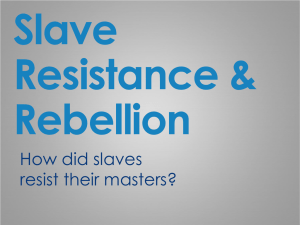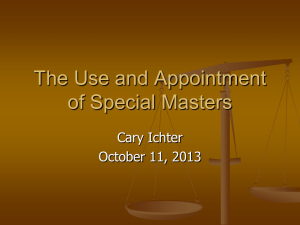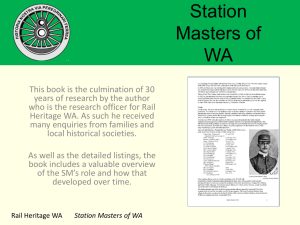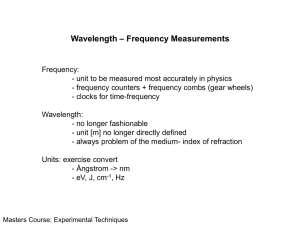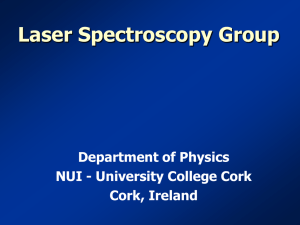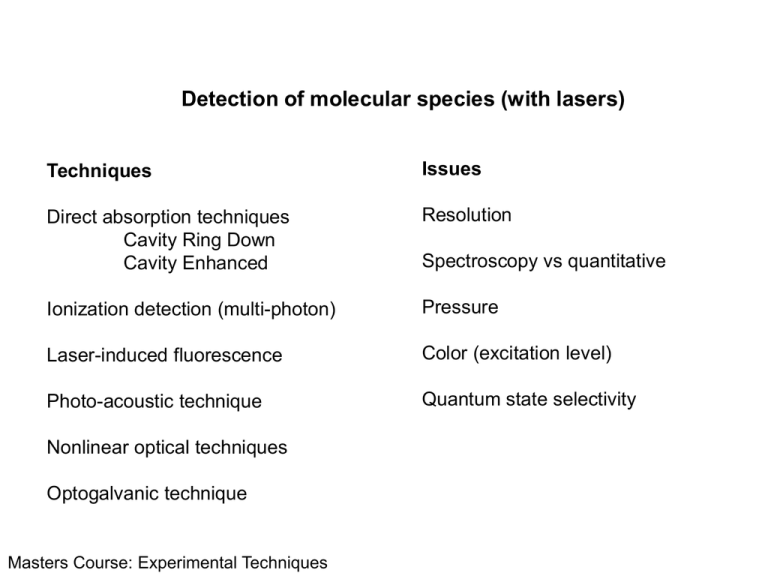
Detection of molecular species (with lasers)
Techniques
Issues
Direct absorption techniques
Cavity Ring Down
Cavity Enhanced
Resolution
Ionization detection (multi-photon)
Pressure
Laser-induced fluorescence
Color (excitation level)
Photo-acoustic technique
Quantum state selectivity
Nonlinear optical techniques
Optogalvanic technique
Masters Course: Experimental Techniques
Spectroscopy vs quantitative
Direct absorption
Beer’s law, Beer-Lambert law
I I0 exp nl
Exponent
n
cross section in [cm2]
density in [cm-3]
l
absorption length in [cm]
nl
column density in [cm-2]
Problem:
- Measuring against a non-zero baseline
Masters Course: Experimental Techniques
Photo-acoustic detection
RT-VT relaxation
Kinetic energy
= acoustics
Use of acoustic resonator
Phase sensitive detection
Acoustic modulation
Masters Course: Experimental Techniques
Optogalvanic detection
Principle: change the resistance over a plasma discharge
by resonantly exciting atoms/molecules
Masters Course: Experimental Techniques
Ionization detection
Various production schemes for ions
Ions/charged particles sensitive detection
Time-of-flight mass spectrometry
Masters Course: Experimental Techniques
CARS = Coherent Anti-Stokes Raman
CARS
CSRS
Production of a coherent beam
of light
Masters Course: Experimental Techniques
BOXCARS
Coherent beams in 3 dimensions
Masters Course: Experimental Techniques
Cavity Ring-Down spectroscopy
Masters Course: Experimental Techniques
Cavity Ring-Down spectroscopy
Masters Course: Experimental Techniques
CRD; the paradigm
empty cavity
What is it good for ?
0
L
c1 R
cavity filled with absorbing gas
0
L
c1 R kL
absorption coefficient; cross section
1 1 1
k n
c 0
Masters Course: Experimental Techniques
- Spectroscopy (not extreme precision)
- Sensitive detection (within limits)
- Intensity – quantitative
(within severe limits/difficulty)
- Gases,
to Solids, Surfaces, Liquids
- Wavelength range
(limited – mirror quality)
Advantages:
-No dependence on laser fluctuations
-Extremely long effective path lengths
-Easy to make “absolute”
L=1 m
R=99.99%
= 30ms
Path=10 km
Weak transitions; in the benchmark CRD molecule: oxygen
b Sg - X Sg (3,0) or d-band
1
lowest electronic states:
O(3P)
+O(3P)
+
3
+
f = 1.3 x 10-14
(104 times weaker than A-band)
P
19
17
in electric dipole approximation:
all transitions “forbidden”
absorption factor (10-9 cm-1 )
20.0
17
16
15
13
13
11
11
9
9
7
7
3
5
5
3
Q
P
P
1
O2
10.0
0.0
17165.0
Masters Course: Experimental Techniques
15
17190.0
17215.0
17240.0
cm-1
CRD in quantitative spectroscopy: Rayleigh Scattering
single molecule cross section
J.W. Strutt,
3rd Baron of Rayleigh
1899: full theory based on
Electromagnetism
1918: Depolarization effects
R.J. Strutt
1923: Depolarization and
Cross section: King
1969: Full QM theory - Penney
2
2
n
–
1
3 4
24
- ----------------------=
-----------------F
k
2
2
N
n 2 + 2
King factor: polarization effect
6 3r n 3 6 r p
Fk
1 2
6 7 r n 3 4 r p
3
2
1
rn, rp molecular depolarization,
=
4+
No distinction of fine structure:
Raman, Brillouin, Rayleigh wing, Cabannes
Masters Course: Experimental Techniques
Rayleigh scattering from the
Index of refraction !
Rayleigh scattering: direct measurement
Cavity Loss:
b/c = |lnR|/L + N
= 4+
SF6
for N2: th = 23.00 (0.23) 10-45
exp = 22.94 (0.12) 10-45
for Ar: th = 20.04 (0.05) 10-45
Ar
exp = 19.89 (0.14) 10-45
for SF6: th = 183 (6) 10-45
exp = 180 (6) 10-45
Theory – QM - ab initio: Oddershede/Svendsen
(N2, 500 nm): 6.2 x 10-27 cm2/molecule (10% off)
method: Naus and Ubachs, Opt. Lett. 25 (2000) 347
Masters Course: Experimental Techniques
To the liquid phase: The combination CRD – HPLC in our approach
100 ps,
10 Hz
> mJ
Philosophy: Liquid-Only cell
First steps
and goals
effective volume
12 mL
Detection, not spectroscopy
Small volumes
Universal wavelengths
Masters Course: Experimental Techniques
Demonstration of online HPLC detection in Liquid-Only cell
liquid-only cavity
(14 μl)
R = 99.996 %
532 nm, 100 ps,
10 Hz, =70 ns
CRD
chromatogram
Conventional
chromatogram
Detection limit: 15 nM for = 1 x 104 M-1cm-1
Baseline: 2.7 x 10-6 A.U. (1s)
Masters Course: Experimental Techniques
vd Sneppen et al, Anal. Chim. Acta 2006
Evanescent wave CRDS
Ex, Ey, Ez fields
Penetration depth, vs.
Effective depth
EW-CRDS
principle
h=~8 (high sensitivity for top layer)
Target
Biosensor
Masters Course: Experimental Techniques
Toward a biosensor (cytochrome c as test molecule)
70o prisms
l = 538 nm
Absorption signal of cyt c
on various surfaces
NH2-coated surface
bare silica
C18-coating
Result:
C18 surface yields irreversable binding
NH2 surface (+ charged) releaves cyt c
Masters Course: Experimental Techniques
Quantum beat spectroscopy
Excitation of a coherent superposition of quantum states
t 0 ck k 0 c1 1 0 c2 2 0
k
Limitation
Natural lifetime
(not laser pulse !!)
Temporal evolution of the superposition
t ck k 0ei
k
k
/ 2 t
k
Total fluorescence emitted
I t t m m
2
So
I t et A B cos21t
with
A c12 1 m m
2
c22 2 m m
B 2c1c2 1 m m 2 m m
Masters Course: Experimental Techniques
2
Direct frequency comb spectroscopy
Excitation with
phase controlled
ultra-short pulses.
Evolution atomic phase:
Ee E g
exp i
t
Interference between
pulse contributions;
Ramsey fringes in time
Masters Course: Experimental Techniques
Direct frequency comb spectroscopy
Probe the oscillation of the
wave function
Find the right “mode”
Masters Course: Experimental Techniques


